Aluminum Gantry Crane for Handling Equipment & Sample in Lab
Aluminum Gantry Crane for Handling Equipment & Sample in Lab
Aluminum gantry crane for laboratory applications.Aluminum gantry crane 0.5 ton to 5 ton for safe & precise handling of scientific equipment & samples.
In laboratories, where precision and safety are paramount, the choice of equipment plays a pivotal role. Among these tools, aluminum gantry cranes stand out for their versatility and reliability in handling scientific equipment and samples.
Aluminum gantry cranes are renowned for their lightweight yet robust construction, making them ideal for laboratory environments where maneuverability and durability are crucial. These cranes typically feature adjustable height and span options, allowing for precise customization to fit various laboratory setups and requirements.
In laboratory settings, safety and precision are non-negotiable. From delicate scientific instruments to valuable samples, the need for careful handling cannot be overstated. Any mishandling or damage to equipment and samples could lead to costly setbacks, compromised research outcomes, or even safety hazards for laboratory personnel.
Ensuring that laboratory equipment and samples are handled with the utmost care and precision is not just a matter of best practice—it's a fundamental requirement for maintaining the integrity and reliability of scientific research and experimentation. This is where aluminum gantry cranes play a crucial role, providing a safe, efficient, and reliable solution for lifting and moving equipment and samples within laboratory environments.
Key Considerations for Laboratory Applications
In the dynamic realm of laboratory applications, safety and precision are paramount. When integrating aluminum gantry cranes into laboratory environments, several key considerations must be taken into account to ensure the utmost safety and accuracy in handling scientific equipment and samples.
Safety Requirements and Regulations
Laboratories are governed by stringent safety regulations and standards to protect personnel, equipment, and the environment. Before deploying aluminum gantry cranes, it's imperative to thoroughly understand and comply with these regulations. This includes ensuring that the cranes meet all safety standards, such as load capacity ratings, structural integrity, and appropriate safety features like emergency stop buttons and overload protection systems.
Additionally, conducting regular inspections and maintenance checks is essential to keep the gantry cranes in optimal working condition and identify any potential safety hazards. By adhering to safety requirements and regulations, laboratories can create a secure working environment and minimize the risk of accidents or injuries associated with crane operations.
Precision and Accuracy in Handling Scientific Equipment and Samples
Laboratory experiments and research often rely on the precise handling of scientific equipment and samples. Whether it's positioning sensitive instruments, transferring delicate samples, or manipulating intricate components, accuracy is paramount to the success of scientific endeavors.
Aluminum gantry cranes offer the advantage of precise control and maneuverability, allowing operators to position equipment and samples with exceptional accuracy. Their adjustable height and span options enable customization to fit the specific requirements of laboratory setups, ensuring precise placement and alignment of equipment and samples.
Furthermore, integrating specialized lifting attachments, such as hoists with variable speed controls or vacuum lifters for delicate samples, can further enhance precision and accuracy in handling laboratory materials.
By prioritizing safety requirements and regulations and emphasizing precision and accuracy in handling scientific equipment and samples, laboratories can leverage aluminum gantry cranes as indispensable tools for their research and experimentation endeavors.
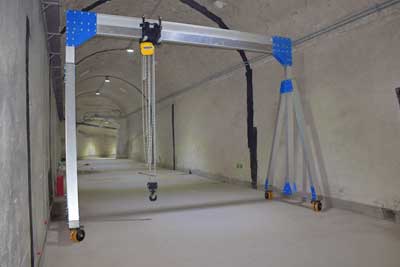
LT1: Aluminum Gantry Crane with Fixed Span and Height
- Capacity up to 5 tons.
- Span up to 4 meters.
- Max. height up to 5 meters
Get Fixed Span & Fixed Hight Aluminum Alloy Gantry Crane Price
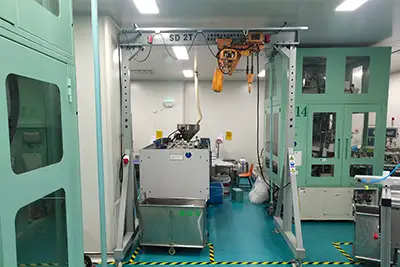
lT 2 Height Adjustable Aluminum Gantry Cranes
- Capacity up to 5 tons.
- Span up to 4 meters.
- Max. height up to 5 meters
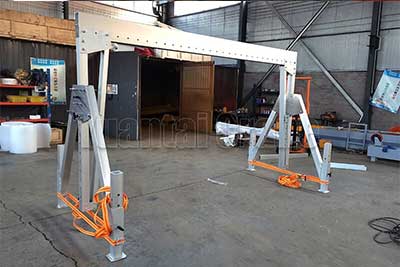
LT3: Fixed Aluminum Gantry Crane with Adjustable Span and Height
- Capacity up to 2 tons.
- Span up to 4 meters.
- Max. height up to 4 meters
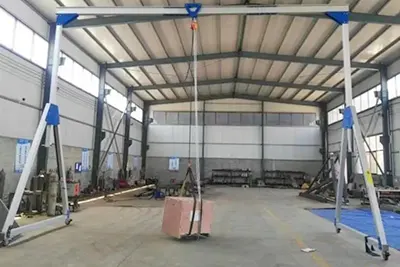
lT4 Simple Gantry Cranes with adjustable Height & Span
- Capacity up to 2 tons.
- Span up to 4 meters.
- Max. height up to 4 meters
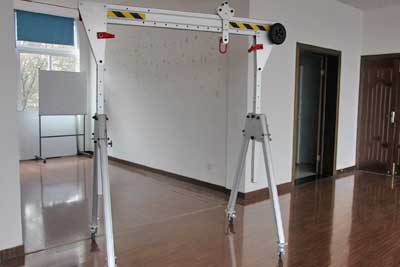
LT5:Foldable Aluminum Gantry Crane with Adjustable Span and Height
- Capacity up to 3 tons.
- Span up to 4 meters.
- Max. lifting height is no more than 6 meters

LT6 Ajustable Gantry Crane with Telescoping Height and Span T Frame Gantry Cranes
- Capacity up to 2 tons.
- Span up to 4 meters.
- Max. lifting height is no more than 4 meters
Customization Options for Laboratory Use
In the specialized environment of laboratories, customization is key to optimizing the functionality and efficiency of aluminum gantry cranes. Tailoring these cranes to meet the specific needs of laboratory applications requires careful consideration of various customization options.
Adjustable Height and Span Features
One of the primary customization options for aluminum gantry cranes in laboratory settings is adjustable height and span features. Laboratories often have unique spatial constraints, varying ceiling heights, and specialized equipment setups. Adjustable height and span features allow gantry cranes to be configured to accommodate these specific requirements, ensuring precise positioning of equipment and samples.
By adjusting the height and span of the crane, operators can optimize workspace utilization, minimize interference with other equipment or structures, and facilitate seamless movement within the laboratory environment. This flexibility enhances the versatility of gantry cranes, making them indispensable tools for a wide range of laboratory applications.
Load Capacity and Handling Attachments
Customization options related to load capacity and handling attachments are essential for meeting the diverse handling needs of laboratory equipment and samples. Laboratories often deal with a variety of loads, ranging from small, delicate samples to larger, heavier equipment.
By customizing the load capacity of gantry cranes to match specific lifting requirements, laboratories can ensure safe and efficient handling of various loads. Additionally, integrating specialized handling attachments, such as precision hoists, vacuum lifters, or adjustable clamps, further enhances the versatility and functionality of gantry cranes in laboratory settings.
Mobility and Portability Enhancements
Mobility and portability enhancements are particularly valuable customization options for laboratory gantry cranes, allowing for seamless integration into dynamic laboratory environments. Laboratories often require flexibility in equipment positioning and frequent reconfiguration of workspace layouts.
Features such as swivel casters, foldable components, and lightweight materials enhance the mobility and portability of gantry cranes, making them easy to maneuver and transport within the laboratory. This agility enables laboratories to adapt quickly to changing experimental setups or relocate equipment as needed, maximizing operational efficiency and productivity.
By leveraging adjustable height and span features, customizing load capacity and handling attachments, and incorporating mobility and portability enhancements, laboratories can tailor aluminum gantry cranes to meet the specific demands of their research and experimentation activities, ensuring safe and precise handling of scientific equipment and samples.
Case Studies: Successful Implementation in Laboratories
Aluminum gantry cranes have become indispensable tools in various laboratory settings, facilitating safe and precise handling of scientific equipment and samples. Let's explore some successful case studies highlighting the implementation of these cranes in different types of laboratories.
Research Laboratories
Research laboratories often deal with delicate scientific instruments and sensitive materials that require careful handling. In such environments, aluminum gantry cranes with adjustable height and span features are invaluable assets.
Case Study: A prominent research laboratory specializing in materials science adopted aluminum gantry cranes equipped with adjustable height and span features to support their experimental activities. These cranes provided the flexibility needed to navigate through crowded laboratory spaces and position equipment with precision. The ability to customize the crane's configuration allowed researchers to optimize workspace utilization and streamline their workflows, ultimately enhancing productivity and experimental outcomes.
Testing Facilities
Testing facilities rely on accurate and efficient handling of test specimens and equipment to ensure reliable results. Aluminum gantry cranes with tailored load capacity and handling attachments play a vital role in meeting the unique requirements of testing laboratories.
Case Study: A leading testing facility specializing in mechanical testing implemented aluminum gantry cranes with customized load capacity and specialized lifting attachments. These cranes were designed to safely handle a wide range of test specimens, from small components to large structures, with precision and ease. The integration of specialized handling attachments, such as adjustable clamps and tensioning devices, enabled technicians to perform tests efficiently and accurately, contributing to the facility's reputation for delivering high-quality testing services.
Quality Control Laboratories
Quality control laboratories play a crucial role in ensuring the integrity and safety of products through rigorous inspection and testing processes. Aluminum gantry cranes with mobility and portability enhancements offer flexibility and efficiency in handling inspection equipment and samples.
Case Study: A renowned quality control laboratory in the pharmaceutical industry adopted aluminum gantry cranes equipped with swivel casters and lightweight materials to enhance mobility and portability. These cranes enabled inspectors to move seamlessly between different testing stations, facilitating the inspection of samples and equipment with minimal disruption. The gantry cranes' agility and ease of maneuverability contributed to faster turnaround times for quality control processes, ensuring timely product releases and compliance with regulatory standards.
These case studies demonstrate the versatility and effectiveness of aluminum gantry cranes in supporting various laboratory activities, from research and testing to quality control. By customizing these cranes to meet specific laboratory requirements, organizations can enhance efficiency, accuracy, and safety in their scientific endeavors.
Benefits of Using Aluminum Gantry Cranes in Laboratories
Aluminum gantry cranes offer numerous advantages for laboratory environments, where precision, safety, and efficiency are paramount. Let's delve into the benefits of incorporating these cranes into laboratory operations:
Enhanced Safety for Personnel and Equipment
Laboratories often house expensive and delicate equipment, as well as hazardous materials and chemicals. Aluminum gantry cranes provide a safe and reliable means of lifting and moving these items without risking injury to personnel or damage to equipment. With features such as adjustable height and precision controls, gantry cranes allow operators to maneuver loads with precision, minimizing the risk of accidents and ensuring the safety of laboratory staff and assets.
Increased Efficiency and Productivity in Handling Operations
Time is of the essence in laboratory settings, where experiments, tests, and analyses are conducted with strict deadlines. Aluminum gantry cranes streamline handling operations by providing a quick and efficient means of lifting, transporting, and positioning equipment, samples, and specimens. Their customizable features, such as adjustable height and load capacity, enable operators to adapt the crane to suit the specific requirements of each task, resulting in smoother workflows and increased productivity.
Reduced Risk of Contamination and Damage to Samples
In laboratories, maintaining the integrity of samples and specimens is crucial for ensuring accurate test results and research outcomes. Aluminum gantry cranes help mitigate the risk of contamination and damage by providing a clean and controlled lifting environment. With smooth, corrosion-resistant surfaces and minimal exposed moving parts, gantry cranes minimize the potential for contamination and ensure the safe handling of sensitive samples, reducing the likelihood of costly errors and retests.
In summary, the use of aluminum gantry cranes in laboratories offers significant benefits, including enhanced safety, increased efficiency, and reduced risk of sample contamination or damage. By incorporating these versatile lifting solutions into their operations, laboratories can optimize their handling processes, improve safety standards, and ultimately achieve better research outcomes.
Considerations for Selecting Gantry Cranes for Laboratory Applications
When choosing gantry cranes for laboratory use, several factors must be taken into account to ensure optimal performance, safety, and compliance. Here are key considerations to keep in mind:
Compatibility with Laboratory Environment and Equipment
Laboratories have unique environments with specific space constraints, layout considerations, and equipment configurations. When selecting a gantry crane, it's essential to ensure compatibility with the laboratory's infrastructure and equipment. This includes assessing factors such as available space for crane installation, ceiling height restrictions, and the need to navigate around existing laboratory apparatus. Choosing a gantry crane with adjustable height and span features can help accommodate varying workspace configurations and ensure seamless integration with laboratory equipment.
Budgetary Constraints and Long-Term Value
Budget considerations are a crucial aspect of any equipment purchase, including gantry cranes for laboratory applications. While it's important to select a crane that meets the laboratory's immediate needs, it's equally essential to consider the long-term value and return on investment. Investing in a high-quality gantry crane with durable construction and advanced features may require a higher upfront cost but can result in lower maintenance expenses and longer service life over time. Conducting a cost-benefit analysis and weighing the upfront investment against potential long-term savings can help laboratories make informed decisions that align with their budgetary constraints and operational requirements.
Compliance with Industry Standards and Regulations
Laboratories are subject to stringent safety regulations and industry standards governing equipment usage and workplace safety. When selecting a gantry crane, it's imperative to ensure compliance with relevant regulatory requirements and standards, such as those set forth by occupational health and safety administrations or industry-specific governing bodies. Choosing a gantry crane from reputable manufacturers with a proven track record of compliance and adherence to safety standards can provide laboratories with peace of mind and ensure the safety of personnel and equipment during crane operations.
By carefully considering these factors and selecting gantry cranes that are compatible with the laboratory environment, offer long-term value, and comply with industry standards, laboratories can make informed decisions that enhance safety, efficiency, and productivity in their operations.
Conclusion
In conclusion, aluminum gantry cranes offer a versatile solution for handling scientific equipment and samples in laboratory environments. By providing a recap of key points, highlighting the importance of selecting the right gantry crane for laboratory needs, and discussing future trends in laboratory equipment handling, we can underscore the significance of this equipment in scientific research and experimentation.
Throughout this discussion, we have explored the various considerations involved in selecting and utilizing aluminum gantry cranes in laboratory settings. We've examined safety requirements, customization options, case studies, benefits, and considerations for selecting the most suitable gantry crane for laboratory applications.
Selecting the right gantry crane is paramount for laboratories to ensure safe and precise handling of scientific equipment and samples. By choosing a crane that is compatible with the laboratory environment, offers long-term value, and complies with industry standards, laboratories can enhance safety, efficiency, and productivity in their operations.
In summary, aluminum gantry cranes play a vital role in laboratory environments, offering a safe, precise, and efficient solution for handling scientific equipment and samples. By understanding the key considerations outlined in this discussion and staying abreast of future trends, laboratories can leverage the full potential of gantry cranes to support their research and experimentation endeavors.




